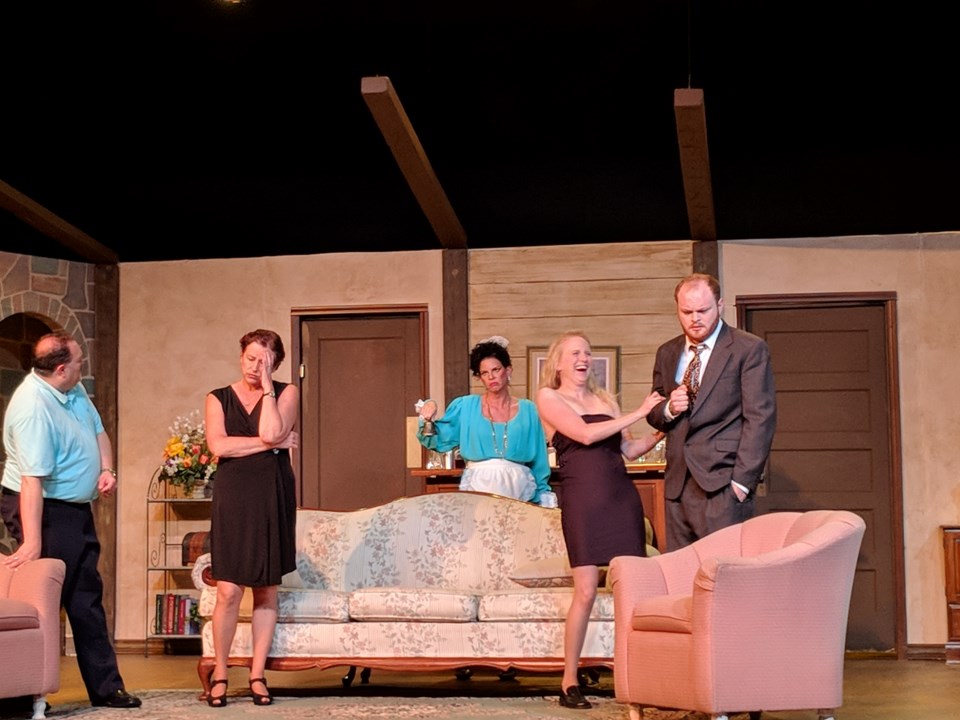This content was originally published by the Longmont Observer and is licensed under a Creative Commons license.
Written by Ellen Anderson: Set in a country home outside Paris, “Don’t Dress For Dinner” begins as Bernard (Jay Moretz) impatiently waits as his weekend plan to wine and dine his mistress, Suzanne (Susan V. Walters), at his home comes together. The phone rings and his wife, Jacqueline (Julie Marino), answers the phone, only to be surprised that Robert (Aaron Bilek), Bernard’s friend, has unexpectedly returned from a business trip and plans to spend the weekend at their home. A suspiciously ecstatic Jacqueline immediately cancels her weekend plans to see her mother ― turns out she’s also been having an affair with Robert.
This cancellation immediately ruins Bernards plans and as Robert enters their home, he attempts to “solve it” with a lie: have Robert state that Suzanne is his mistress. As the production continues throughout the two-hour runtime, the lies get more and more elaborate. Soon, all of the characters, including Suzette (Amy Sonnanstine), the maid who was hired by Bernard to cook for the “special evening”, gets tangled up into a web of hilarious confusion as the lies pile on.
Moretz does a convincingly great job as the husband who keeps digging himself into a bigger hole; Marino is perfectly cast as the sweet and caring wife; Bilek is equally as good and portrays that friend who supports his friends no matter the cost; Walters delivers a wonderful performance as the sultry mistress. But, by far the most comical character is Sonnanstine, perfectly cast as Suzette, who’s outside perspective provides insight into the ridiculousness of the premise of the play and what unfolds.
The costumes, done by Judy Ernst, also reflect that some characters are well-to-do while others are simply at the level of the “cook.” Social status is a common theme during the play, and Suzette, the cook, arrives in a frumpy dress until she is transformed by Robert and Berard to reflect her change in character. Suzanne enters with an outfit meant to reflect a Parisian sophistication, as her character is a model. Jacqueline seems surprisingly accepting of the fact that her “cook” is dressed in such lavish clothing. Bernard frequently changes costume as he is rightfully and wrongfully sprayed with water and drinks from the bar, until by the end all characters somehow end up in their sleeping clothes -- the women meant to entice the men.
The set, designed by Theresa Collins, portrays a living room fit for upper-middle-class socialites that frequently host visitors and the detail in the painted stone, wood walls and the floral couches paints a picture of a family living a comfortable life. The frequently referenced bedrooms with a “very large bed” remain unseen but multiple doors suggest the spare bedrooms open to guests. In the center of the room is a home bar, which characters frequently use to deal with keeping up the night’s pretenses.
Although “Don’t Dress For Dinner” does provide plenty of good laughs throughout the night as the characters sink deeper and deeper into their own deception, the clarifications of the plot and relationships of each character may leave the audience feeling a bit exasperated -- how many times does the audience need to be explained each lie as they watch it unfold? Perhaps, that’s the point -- a farce that keeps growing and growing because who really knows the lies and the explanations one would tell should we find ourselves in that situation.



